Preparation and Characterization of Polypropylene/Sepiolite Nanocomposites for Potential Application in Automotive Lightweight Materials
Abstract
:1. Introduction
2. Materials and Methods
2.1. Materials
2.2. Preparation of PP/OSep Nanocomposites
2.3. Characterization
3. Results and Discussion
3.1. Chemical Structure
3.2. Morphology
3.3. Rheology
3.4. Crystallinity
3.5. Thermal Stability
3.6. Mechanical Properties
3.7. Mold Shrinkage
4. Conclusions
Author Contributions
Funding
Institutional Review Board Statement
Data Availability Statement
Conflicts of Interest
References
- Ray, S.S.; Okamoto, M. Polymer/layered silicate nanocomposites: A review from preparation to processing. Prog. Polym. Sci. 2003, 28, 1539–1641. [Google Scholar]
- Hiziroglu, H.R.; Shkolnik, I.E. Electrical characteristics of polypropylene mixed with natural Nanoclay. Polymers 2018, 10, 942. [Google Scholar] [CrossRef] [PubMed]
- Coburn, N.; Douglas, P.; Kaya, D.; Gupta, J.; McNally, T. Isothermal and non-isothermal crystallization kinetics of composites of poly(propylene) and MWCNTs. Adv. Ind. Eng. Polym. Res. 2018, 1, 99–110. [Google Scholar] [CrossRef]
- Liang, J.Z.; Zou, S.Y.; Du, Q. Impact and flexural properties of polypropylene composites reinforced with multi-walled carbon nanotubes. Polym. Test. 2018, 70, 434–440. [Google Scholar] [CrossRef]
- Causin, V.; Yang, B.X.; Marega, C.; Goh, S.H.; Marigo, A. Nucleation, structure and lamellar morphology of isotactic polypropylene filled with polypropylene-grafted multiwalled carbon nanotubes. Eur. Polym. J. 2009, 45, 2155–2163. [Google Scholar] [CrossRef]
- Lee, S.H.; Kim, M.W.; Kim, S.H.; Youn, J.R. Rheological and electrical properties of polypropylene/MWCNT composites prepared with MWCNT masterbatch chips. Eur. Polym. J. 2008, 44, 1620–1630. [Google Scholar] [CrossRef]
- Zaghloul, M.M.Y.; Zaghloul, M.Y.M.; Zaghloul, M.M.Y. Experimental and modeling analysis of mechanical-electrical behaviors of polypropylene composites filled with graphite and MWCNT fillers. Polym. Test. 2017, 63, 467–474. [Google Scholar] [CrossRef]
- Zhang, C.; Ma, Y.; Feng, B.; Han, Z.; Zhang, Z.; Liang, W.; Wang, K. Effects of montmorillonite on structures and properties of injection-molded polypropylene. J. Appl. Polym. Sci. 2019, 136, 47442. [Google Scholar] [CrossRef]
- Zhu, B.; Li, W.; Song, J.; Wang, J. Structure and properties of polypropylene/polyolefin elastomer/organic montmorillonite nanocomposites. J. Macromol. Sci. B 2018, 58, 73–87. [Google Scholar] [CrossRef]
- Zhu, B.; Zhang, J.; Wang, J.; Liu, J.; Zhang, J. Compatibilisation of multi-monomer grafted poly(ethylene-co-octene) on polypropylene/organo-montmorillonite nanocomposite. Plast. Rubber Compos. 2018, 47, 65–71. [Google Scholar] [CrossRef]
- Rohlmann, C.O.; Horst, M.F.; Quinzani, L.M.; Failla, M.D. Comparative analysis of nanocomposites based on polypropylene and different montmorillonites. Eur. Polym. J. 2008, 44, 2749–2760. [Google Scholar] [CrossRef]
- Szkudlarek, E.; Piorkowska, E.; Boyer, S.A.E.; Haudin, J.M.; Gadzinowska, K. Nonisothermal shear-induced crystallization of polypropylene-based composite materials with montmorillonite. Eur. Polym. J. 2013, 49, 2109–2119. [Google Scholar] [CrossRef]
- Manchanda, B.; Kottiyath, V.K.; Kapur, G.S.; Kant, S.; Choudhary, V. Morphological studies and thermo-mechanical behavior of polypropylene/sepiolite nanocomposites. Polym. Compos. 2017, 38, 285–294. [Google Scholar] [CrossRef]
- Manchanda, B.; Vimal, K.K.; Kapur, G.S.; Kant, S.; Choudhary, V. Effect of sepiolite on nonisothermal crystallization kinetics of polypropylene. J. Mater. Sci. 2016, 51, 9535–9550. [Google Scholar] [CrossRef]
- Pappalardo, S.; Russo, P.; Acierno, D.; Rabe, S.; Schartel, B. The synergistic effect of organically modified sepiolite in intumescent flame retardant polypropylene. Eur. Polym. J. 2016, 76, 196–207. [Google Scholar] [CrossRef]
- Xu, L.; Liu, C.; Liu, S. Micro-structure and mechanical property of polypropylene composites filled with modified attapulgite. Appl. Mech. Mater. 2012, 177, 1384–1387. [Google Scholar] [CrossRef]
- Chen, J.; Chen, J.; Zhu, S.; Cao, Y.; Li, H. Mechanical properties, morphology, and crystal structure of polypropylene/chemically modified attapulgite nanocomposites. J. Appl. Polym. Sci. 2011, 121, 899–908. [Google Scholar] [CrossRef]
- Zhang, X.; Guo, J.; Zhang, L.; Yang, S.; Zhang, J.; He, Y. Rheological properties of polypropylene/attapulgite nanocomposite. J. Nanosci. Nanotechno. 2010, 10, 5277–5281. [Google Scholar] [CrossRef]
- Sun, W.; Tang, W.; Gu, X.; Zhang, S.; Sun, J.; Li, H.; Liu, X. Synergistic effect of kaolinite/halloysite on the flammability and thermostability of polypropylene. J. Appl. Polym. Sci. 2018, 135, 46507. [Google Scholar] [CrossRef]
- Demori, R.; Bischoff, E.; Azeredo, A.P.d.; Liberman, S.A.; Maia, J.; Mauler, R.S. Morphological, thermo-mechanical, and thermal conductivity properties of halloysite nanotube-filled polypropylene nanocomposite foam. J. Cell. Plast. 2018, 54, 217–233. [Google Scholar] [CrossRef]
- Marques, M.F.V.; Rosa, J.L.S.; Silva, M.C.V. Nanocomposites of polypropylene with halloysite nanotubes employing in situ polymerization. Polym. Bull. 2017, 74, 2447–2464. [Google Scholar] [CrossRef]
- Soheilmoghaddam, M.; Wahit, M.U.; Yussuf, A.A.; Saleh, M.A.; Whye, W.T. Characterization of bio regenerated cellulose/sepiolite nanocomposite films prepared via ionic liquid. Polym. Test. 2014, 33, 121–130. [Google Scholar] [CrossRef]
- Hassan, S.A.B.; Stojanovićn, D.B.; Kojović, A.; Janković-Castvan, I.; Janaćković, D.; Uskoković, P.S.; Aleksić, R. Preparation and characterization of poly(vinyl butyral) electrospun nanocomposite fibers reinforced with ultrasonically functionalized sepiolite. Ceram. Int. 2014, 40, 1139–1146. [Google Scholar] [CrossRef]
- Pappalardo, S.; Acierno, D.; Russo, P. Influence of intumescent flame retardant and sepiolite on the mechanical and rheological behavior of polypropylene. In Proceedings of the VIII International Conference on “Times of Polymers and Composites”, Naples, Italy, 19–23 June 2016. [Google Scholar]
- Hsieh, A.J.; Moy, P.; Beyer, F.L.; Madison, P.; Napadensky, E. Mechanical response and rheological properties of polycarbonate layered-silicate nanocomposites. Polym. Eng. Sci. 2004, 44, 825–837. [Google Scholar] [CrossRef]
- Vaia, R.A.; Giannelis, E.P. Lattice model of polymer melt intercalation in organically-modified layered silicates. Macromolecules 1997, 30, 7990–7999. [Google Scholar] [CrossRef]
- Hyun, Y.H.; Lim, S.T.; Choi, H.J.; Jhon, M.S. Rheology of poly(ethylene-oxide)/organoclay nanocomposites. Macromolecules 2001, 34, 8084–8093. [Google Scholar] [CrossRef]
- Kracalik, M. Recycled clay/PET nanocomposites evaluated by novel rheological analysis approach. Appl. Clay Sci. 2018, 166, 181–184. [Google Scholar] [CrossRef]
- Nosova, N.; Roiter, Y.; Samaryk, V.; Varvarenko, S.; Stetsyshyn, Y.; Minko, S.; Stamm, M.; Voronov, S. Polypropylene surface peroxidatioon with heterofunctional polyperoxides. Macromol. Symp. 2004, 210, 339–348. [Google Scholar] [CrossRef]
- Kickelbick, G. Concepts for the incorporation of inorganic building blocks into organic polymers on a nanoscale. Prog. Polym. Sci. 2003, 28, 83–114. [Google Scholar] [CrossRef]

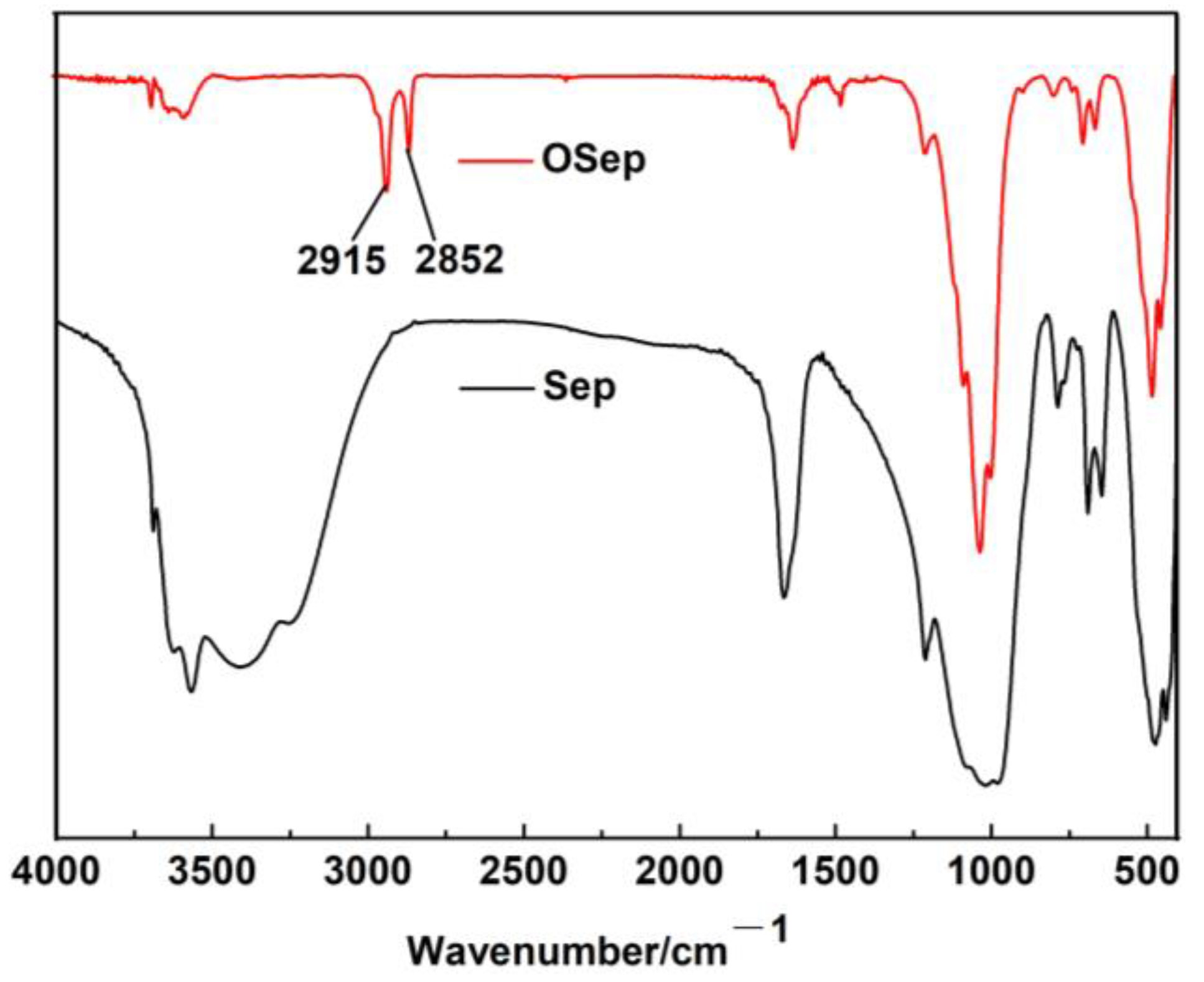
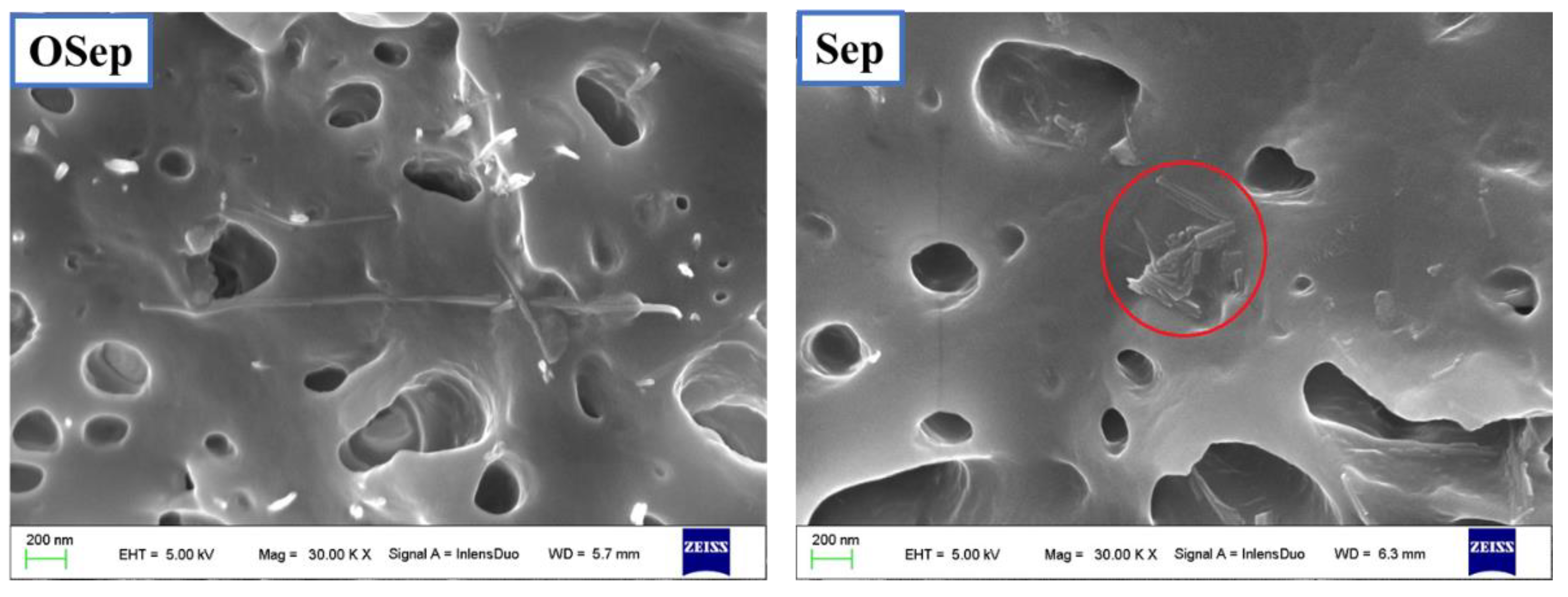

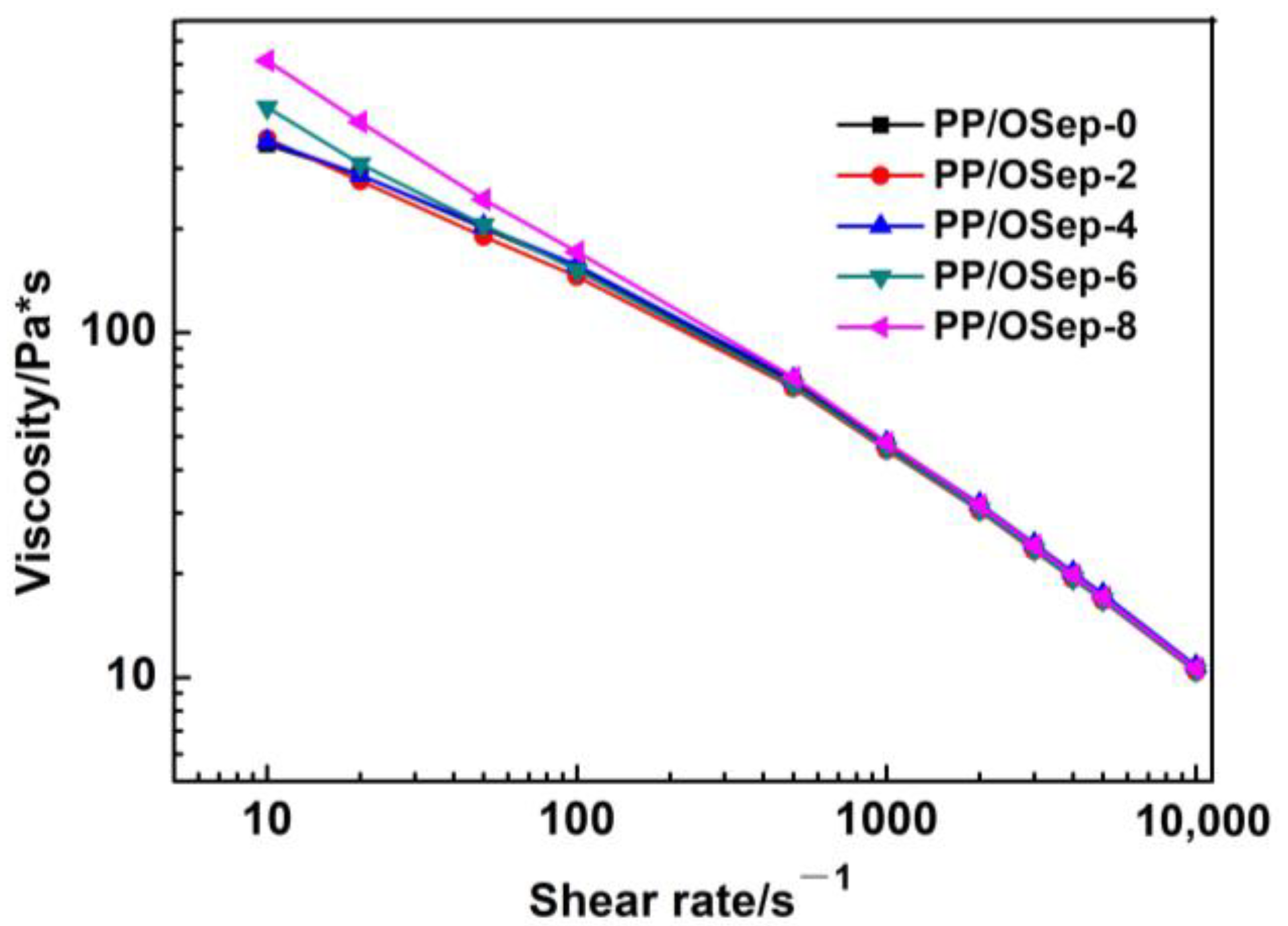
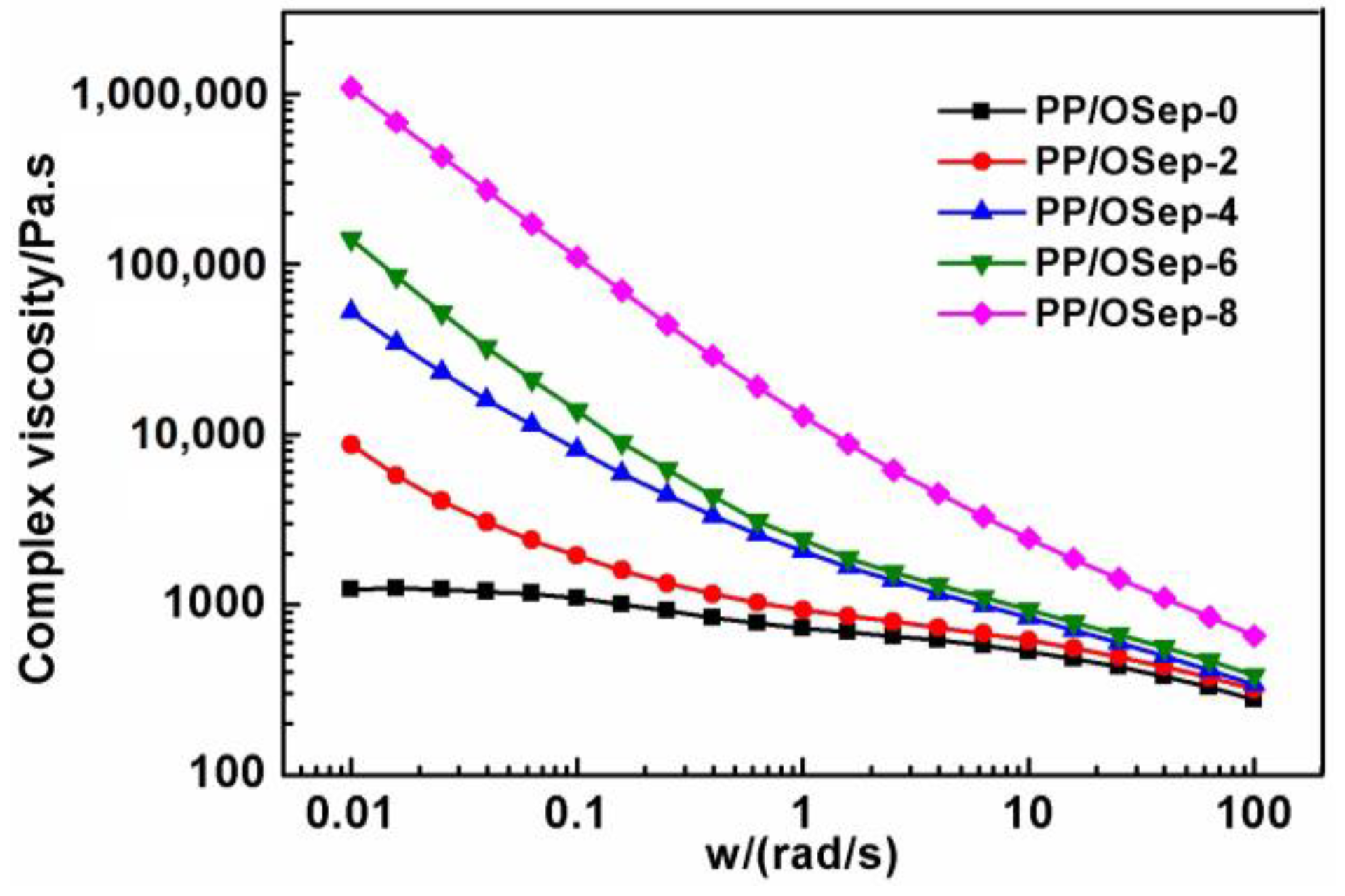



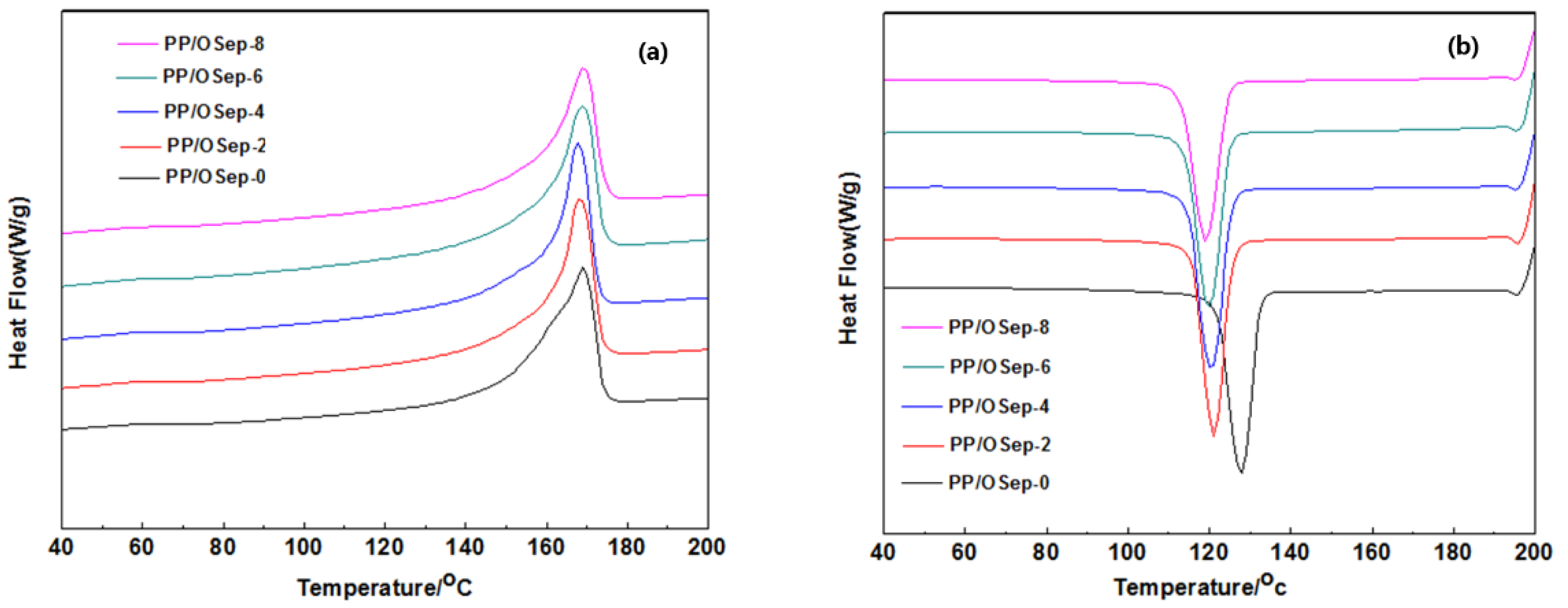

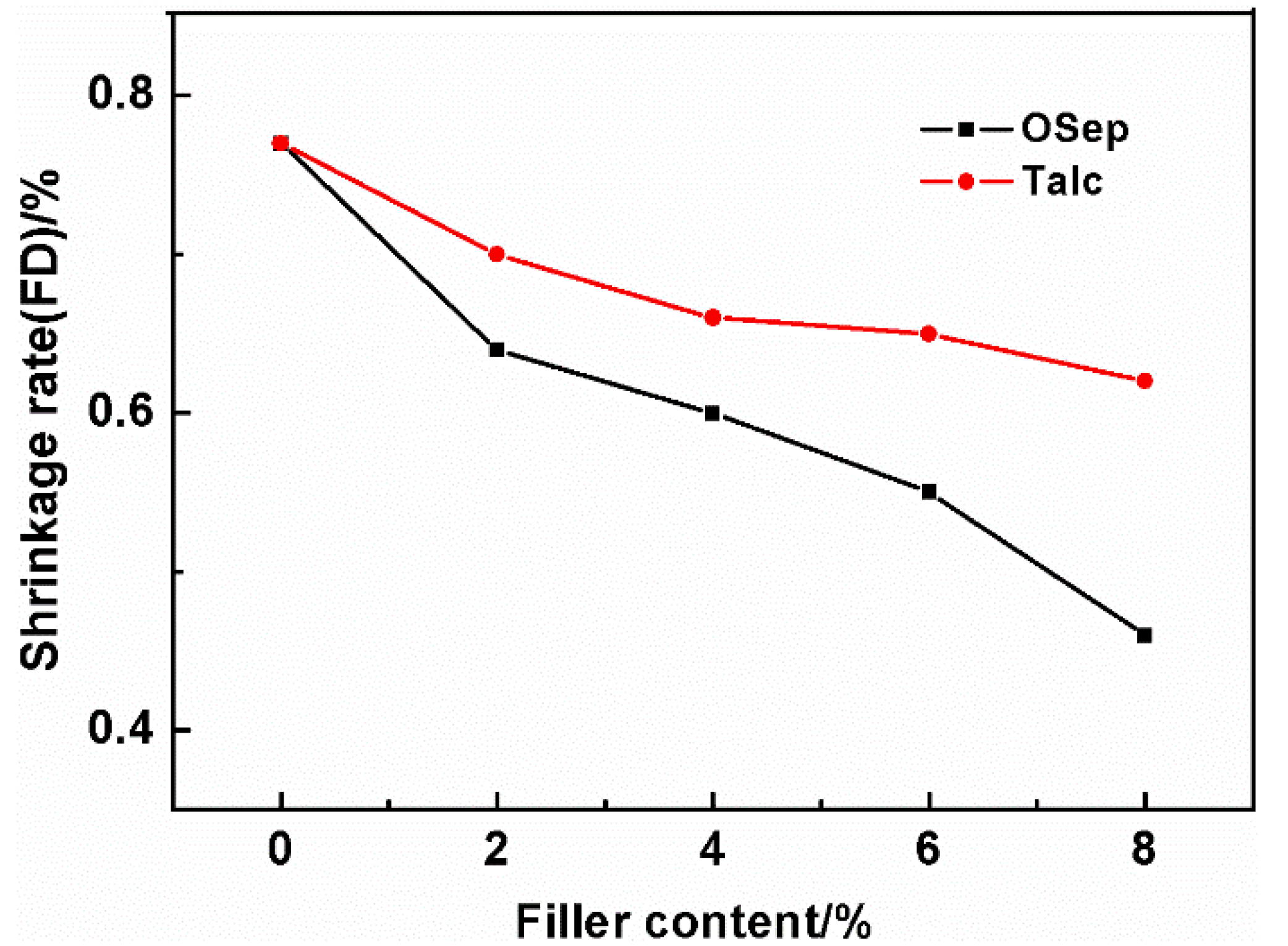
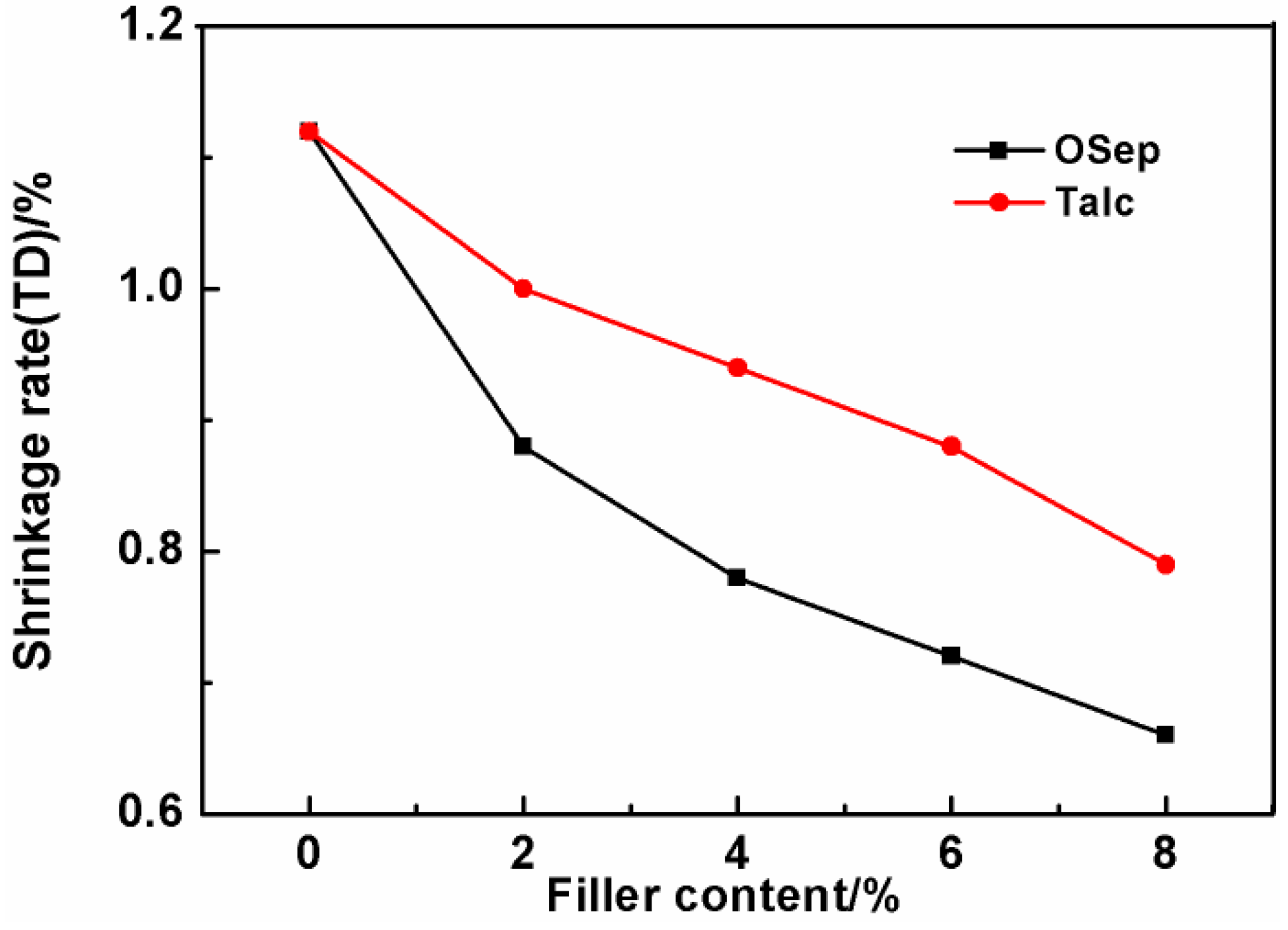
| Samples | PP/OSep-0 | PP/OSep-2 | PP/OSep-4 | PP/OSep-6 | PP/OSep-8 |
|---|---|---|---|---|---|
| PP | 80 | 78 | 76 | 74 | 72 |
| POE | 20 | 20 | 20 | 20 | 20 |
| OSep | 2 | 4 | 6 | 8 |
| Samples | PP/OSep-0 | PP/OSep-2 | PP/OSep-4 | PP/OSep-6 | PP/OSep-8 |
|---|---|---|---|---|---|
| MFR (g/10 min), 230 °C/2.16 Kg | 25.8 | 30.7 | 28 | 22 | 17.8 |
| Samples | PP/OSep-0 | PP/OSep-2 | PP/OSep-4 | PP/OSep-6 | PP/OSep-8 |
|---|---|---|---|---|---|
| ΔHm (J/) | 63.8 | 62.4 | 61.3 | 60.4 | 59.2 |
| Tc (°C) | 127.8 | 121 | 120.4 | 119.9 | 119.1 |
| Samples | Flexural Modulus (MPa) | Izod Notched Impact Strength (KJ/m2) |
|---|---|---|
| PP/OSep-0 | 1150 | 24.4 |
| PP/OSep-2 | 1202 | 7.4 |
| PP/OSep-4 | 1331 | 6.6 |
| PP/OSep-6 | 1453 | 9.2 |
| PP/OSep-8 | 1584 | 18.3 |
Disclaimer/Publisher’s Note: The statements, opinions and data contained in all publications are solely those of the individual author(s) and contributor(s) and not of MDPI and/or the editor(s). MDPI and/or the editor(s) disclaim responsibility for any injury to people or property resulting from any ideas, methods, instructions or products referred to in the content. |
© 2023 by the authors. Licensee MDPI, Basel, Switzerland. This article is an open access article distributed under the terms and conditions of the Creative Commons Attribution (CC BY) license (https://creativecommons.org/licenses/by/4.0/).
Share and Cite
Wu, G.; Lei, L.; Wu, Y.; Yu, F.; Li, J.; He, H. Preparation and Characterization of Polypropylene/Sepiolite Nanocomposites for Potential Application in Automotive Lightweight Materials. Polymers 2023, 15, 802. https://doi.org/10.3390/polym15040802
Wu G, Lei L, Wu Y, Yu F, Li J, He H. Preparation and Characterization of Polypropylene/Sepiolite Nanocomposites for Potential Application in Automotive Lightweight Materials. Polymers. 2023; 15(4):802. https://doi.org/10.3390/polym15040802
Chicago/Turabian StyleWu, Guofeng, Liang Lei, Yijian Wu, Fei Yu, Jianjun Li, and Hui He. 2023. "Preparation and Characterization of Polypropylene/Sepiolite Nanocomposites for Potential Application in Automotive Lightweight Materials" Polymers 15, no. 4: 802. https://doi.org/10.3390/polym15040802
APA StyleWu, G., Lei, L., Wu, Y., Yu, F., Li, J., & He, H. (2023). Preparation and Characterization of Polypropylene/Sepiolite Nanocomposites for Potential Application in Automotive Lightweight Materials. Polymers, 15(4), 802. https://doi.org/10.3390/polym15040802










